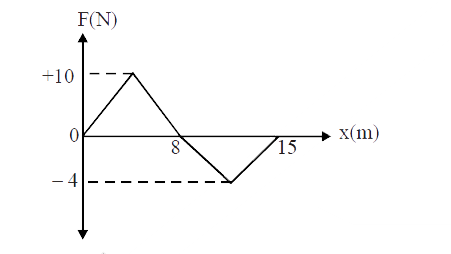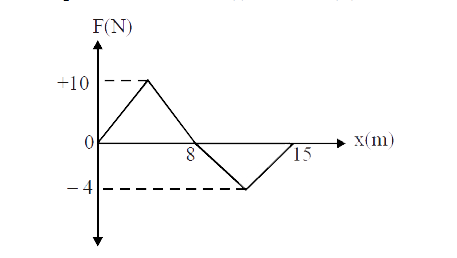On an object of mass 1 kg moving along x-axis with constant speed 8 m/s, a constant force 2 N is applied in positive y-direction. Find its speed after 4 seconds.
To solve the problem step by step, we will analyze the motion of the object under the influence of the applied force.
Step 1: Identify the given information
- Mass of the object (m) = 1 kg
- Initial speed along the x-axis (u_x) = 8 m/s
- Force applied in the y-direction (F) = 2 N
- Time duration (t) = 4 s
Step 2: Calculate the acceleration in the y-direction
Using Newton's second law, we can find the acceleration (a) in the y-direction:
F=m⋅a
Rearranging gives:
a=Fm
Substituting the values:
a=2N1kg=2m/s2
Step 3: Determine the initial velocity in the y-direction
Since the object is moving along the x-axis and there is no initial motion in the y-direction, we have:
uy=0m/s
Step 4: Calculate the final velocity in the y-direction after 4 seconds
Using the equation of motion:
vy=uy+a⋅t
Substituting the values:
vy=0+(2m/s2)⋅(4s)=8m/s
Step 5: Determine the final velocity in the x-direction
The object is moving with a constant speed in the x-direction, so:
vx=ux=8m/s
Step 6: Calculate the overall velocity
The overall velocity of the object can be represented as a vector:
→v=vx^i+vy^j
Substituting the values:
→v=8^i+8^j
Step 7: Calculate the magnitude of the overall velocity
The magnitude of the velocity vector can be calculated using the Pythagorean theorem:
|→v|=√v2x+v2y
Substituting the values:
|→v|=√(8m/s)2+(8m/s)2
|→v|=√64+64=√128=8√2m/s
Final Answer
The speed of the object after 4 seconds is 8√2m/s.
---
- Mass of the object (m) = 1 kg
- Initial speed along the x-axis (u_x) = 8 m/s
- Force applied in the y-direction (F) = 2 N
- Time duration (t) = 4 s
Using Newton's second law, we can find the acceleration (a) in the y-direction:
F=m⋅a
Rearranging gives:
a=Fm
Substituting the values:
a=2N1kg=2m/s2
Since the object is moving along the x-axis and there is no initial motion in the y-direction, we have:
uy=0m/s
Using the equation of motion:
vy=uy+a⋅t
Substituting the values:
vy=0+(2m/s2)⋅(4s)=8m/s
The object is moving with a constant speed in the x-direction, so:
vx=ux=8m/s
The overall velocity of the object can be represented as a vector:
→v=vx^i+vy^j
Substituting the values:
→v=8^i+8^j
The magnitude of the velocity vector can be calculated using the Pythagorean theorem:
|→v|=√v2x+v2y
Substituting the values:
|→v|=√(8m/s)2+(8m/s)2
|→v|=√64+64=√128=8√2m/s
The speed of the object after 4 seconds is 8√2m/s.
Similar Questions
A body of mass 2 kg is moving along x-direction with a velocity of 2 m/sec. If a force of 4 N is applied on it along y-direction for 1 sec, the final velocity of particle willbe-
View SolutionA car moves with a constant speed toward East. A force is applied on the car to make it stop. The direction of the applied force is toward
View Solution
Knowledge Check
A particle of mass m is moving with constant speed v on the line y=b in positive x-direction. Find its angular momentum about origin, when position coordinates of the particle are (a, b).
AmvbBmvb/2Cmvb/4DnoneAn object of mass 10kg moves at a constant speed of 10 ms−1. A constant force, that acts for 4 sec on the object, gives it a speed of 2ms−1 in opposite direction. The force acting on the object is :
A−3NB−30NC3ND30NAn object of mass 20 kg moves at a constant speed of 5ms−1. A constant force, that acts for 2 sec on the object, gives it a speed of 3ms−1 in opposite direction. The force acting on the object is
A8NB−80NC−8ND80N
An object of mass 10 kg is moving with an initial velocity of 10ms−1. A constant force acts for 4 s on the object giving it a speed of 2 m s−1 in the opposite direction. Find the acceleration and force.
View SolutionAn object of mass 4 kg moving along x-axis crosses origin with 4 m/s towards positive direction. A force begins to act on the objection variation of which with x-coordinate is as shown in the graph. Find its speed when it is at
x=8m

View SolutionAn object of mass 4 kg moving along x-axis crosses origin with 4 m/s towards positive direction. A force begins to act on the objection variation of which with x-coordinate is as shown in the graph. Find its speed when it is at
x=15m

View SolutionAn object of mass 10 kg is moving with an initial velocity of 10ms−1. A constant force acts for 4 s on the object giving it a speed of 2 m s−1 in the opposite direction. Find the acceleration and force.
View SolutionA block of mass 5 kg is moving with a speed of 8 m/s. A force of 10 N is applied on it for 3 s . Find the final speed of the block if the force is applied (i) along the motion , (ii) opposite to the motion and (iii) normal to the intial direction of motion of the block.
View Solution